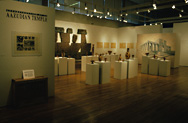THE APASHT
The Apasht were an important Neolithic culture situated in the Hindoo Kush Mountains of Afghanistan from 3000 B.C.E. to roughly 1500 B.C.E. While most scholars agree they played a formative role in the development of Vedic Culture, many essential points are still disputed. No conclusive evidence exists whether the Apasht had cultural contact with the Aazudians Given the puzzling nature of the Apasht, the Baluchistani scholar, poet and vegetarian Aziz Farhat Rashiduzzaman named them after the Urdu word meaning to be "unintelligible."
Travelers to Afghanistan have encountered Apashtian ruins for centuries. Greek Bactrian troops mapped several sites as early as the fourth century BCE. The Ghurid ruler Ala-aldin Husain burned and ransacked one site in the twelfth century in the belief that the Apasht were demonic. The earliest modern traveler to encounter the Apasht was the Englishman Charles Masson who left the following inscription on the Etanicullah Monument in 1834:
"If any fool this high samooth explore, know Charles Masson has been here before."
The most extensive excavation of the Apasht was conducted by Andres Goddard Foucher for the Delegation Archaeologique Francais en Afghanistan. A central focus of Foucher¹s work was the Etanicullah Monument, which is considered the religious center of their culture. Hokes' reconstruction of the monument appeared in the second volume of the French and English editions of Catalogue of the Apasht Excavations published in 1929 and 1933 respectively. Volume II of this massive tome documents the Apashtian Creation Codex, a press molded clay book which is considered by some to be the earliest printed book in human history, dating from 2400 B.C.E. The codex tells the story of their genesis, in which the first person peacefully coexists with a winged dog and later ingests a sacred mushroom which gives her the ability to self inseminate. Most scholars refer to this individual as the primordial hermaphrodite. This primal act resulted in the creation of the first man and woman, referred to by Apashtologists as the primordial twins. The Apasht believed that all humanity originated from the hermaphrodite. The sacred mushroom, considered by mycologists to be the extremely hallucinogenic and potentially fatal anamita muscaria, appears to have been grown in the codex mounds and ritually consumed.
In a paper titled "The Rise and Fall of the Ancient Apasht" presented to the 2nd Congress of Apashtologists in 1926, Everitt Ormsby Hokes speculated that the sacred drug "soma" cited in the Vedic text the Rg Veda, may be the mushroom o f the Apasht. While a definitive answer to this question eludes us, we do know that Hokes' experimentation with the mushroom nearly proved to be fatal.
For more information regarding the Apasht, readers are encouraged to consult the Cheekwood Monograph Series, Vol. 12, number 2 (Spring 1992) published by the Cheekwood Museum of Fine Arts in Nashville, Tennessee.
TO VIEW IMAGES FROM THE APASHT, CLICK HERE.
